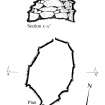St Kilda, Hirta, Village Bay
Cist (Bronze Age)
Site Name St Kilda, Hirta, Village Bay
Classification Cist (Bronze Age)
Canmore ID 9684
Site Number NF19NW 21.24
NGR NF 10125 99234
Datum OSGB36 - NGR
Permalink http://canmore.org.uk/site/9684
- Council Western Isles
- Parish Harris
- Former Region Western Isles Islands Area
- Former District Western Isles
- Former County Inverness-shire
Publication Account (1988)
NF19NW 21.24 10125 99234
This small stone-lined structure lies in the lower meadows on the boundary between the plots formerly associated with Houses 7 and 8. It is roofed by lintels, two of which are exposed and loose on the ground surface. The subterranean chamber is oval on plan, measuring 1.27m in maximum length by 0.91m transversely. The visible remains comprise two courses of masonry, possibly slightly corbelled, standing about 0.4m above a vegetation-covered floor; the full depth is unknown.
Although its precise nature and purpose cannot be determined without excavation, the structure may possibly be an example of one of the types of ancient burial discussed by Mackenzie, who wrote 'Scattered about, here and there, and very numerous, were green mounds called gnocan sithichean, which were looked upon as the abodes of the fairies. These were all removed in the course of agricultural improvements. They were composed of stones mixed with a little earth to a depth of two or three feet. At some distance below this layer were stone coffins formed in two different ways. At times they were formed of four flat stones set on edge and covered by a fifth. At other times both the sides and the roof were formed of several stones set in the same way. These were seemingly of different age from the former. In a few of them bones were found, and in nearly all of them pieces of earthen vessels.'
The structures of the first type are clearly cist-burials and are presumably of Bronze Age or later date. The second type may be compared with the corbelled chamber excavated at Rossinish in Benbecula (NF85SE 5), which was about 1m in internal diameter and was partly sunk into the ground, partly covered by a small mound. The contents of this and associated structures indicated a Bronze Age date.
G P Stell and M Harman 1988.
(Source J B Mackenzie 1911)
Conservation (2001)
NF 101 991 (centre) As part of the Management Agreement with Historic Scotland, the monuments within Village Bay were recorded and monitored, and certain cleits, dykes and enclosures were repaired in 2001 under supervision by members of the two volunteer work parties. Detailed work included the completion of the identification of around 300 cleits for active management, and the production of a report on cleit preservation, as well as rapid assessments of coastal erosion and the deposition of builders' debris within some of the roofless structures along the village street.
Report to be deposited in the NMRS.
Photographic Survey (2002)
NF 101 991 (centre) As part of the Management Agreement with Historic Scotland, the monuments within Village Bay were recorded and monitored, and certain cleits, dykes, drains and enclosures were repaired under supervision by members of the volunteer work parties which went out to St Kilda in 2002.
A photographic survey of the coastline in Village Bay was carried out and compared to images taken in 1999. The survey indicated erosion along the NE side of the bay. Two sherds of hand-made pottery were recovered and a layer of burning noted in an exposed section.
The annual monitoring of cleits across the island was carried out and the photographic survey of them continued.
Report to be deposited in the NMRS.
Sponsors: HS, NTS.
S Bain 2002














